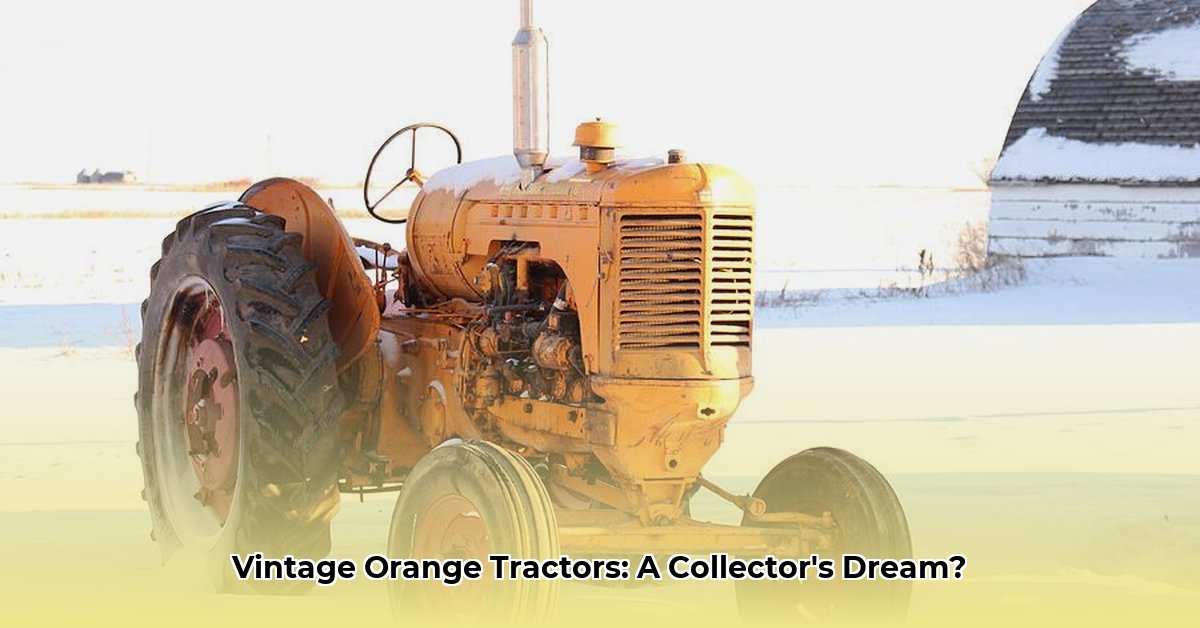
Old Orange Tractor Brands: A Comprehensive Guide
The distinctive orange hue adorning many vintage tractors isn't merely a stylistic choice; it represents a rich history of agricultural innovation and robust machinery. This guide explores prominent brands and models, offering insights into their unique features and historical significance. Whether you're a seasoned collector or a curious enthusiast, this exploration will illuminate the captivating world of old orange tractors. For more images of classic models, see these pictures of old John Deere tractors.
Kubota Tractors: A Legacy of Reliability
Kubota's bright orange has become synonymous with dependable farm equipment. Known for their versatility, these tractors are suitable for various applications, from small family farms to larger agricultural operations. Their compact models excel in precise maneuvering, while larger models tackle demanding fieldwork. Many farmers praise their ruggedness and ease of maintenance, resulting in impressive longevity and strong resale value. The consistent quality has contributed to Kubota's significant market share.
John Deere: Beyond Green and Yellow
While John Deere is famously associated with green and yellow, some older models featured a striking orange paint job. This lesser-known aspect of their history offers a fascinating glimpse into their engineering evolution. Researching these orange John Deere tractors reveals stories of innovation, making them particularly rewarding for enthusiasts.
Kioti Tractors: A Hidden Gem
Often overlooked, Kioti tractors offer a compelling blend of power and affordability. Their compact designs make them highly maneuverable in diverse terrains, while their reasonable price points attract budget-conscious buyers. Many consider Kioti a hidden gem in the vintage tractor market, reflecting their exceptional quality and performance.
Beyond the Big Three: Exploring a Diverse Landscape
The world of old orange tractors extends beyond Kubota, John Deere, and Kioti. Many other manufacturers contributed to this colorful chapter in agricultural history, each with unique characteristics:
Daedong: Renowned for their sturdy construction and exceptional lifespan, these tractors are a testament to durable engineering.
Nuffield (UK): These British tractors hold a significant place in agricultural history, often incorporating innovative features for their time.
Fiat (Italy): Blending Italian style with practical functionality, Fiat tractors represent a unique contribution to the agricultural landscape.
Hesston: While primarily known for their hay balers, some Hesston tractors sported the iconic orange, broadening their legacy in the tractor market.
Massey Ferguson: With models featuring both green and orange paint schemes, Massey Ferguson adds another layer of complexity to the exploration of orange tractors.
Renault Agriculture (France): A major player in European agriculture, Renault tractors offered robust designs tailored to the diverse needs of European farmland.
Ebro (Spain): This Spanish manufacturer produced durable and reliable tractors perfectly suited to the Iberian Peninsula's varied climates and terrains.
Fendt (Germany): Reflecting German engineering precision, these tractors demonstrate a blend of practical functionality and advanced technology.
Steyr (Austria): Known for high-quality tractors emphasizing both performance and longevity, Steyr models are often sought after by collectors and farmers.
Bobcat: While primarily famous for compact equipment, Bobcat also produced noteworthy orange tractor models.
Finding Your Dream Machine: A Buyer's Guide
Acquiring a vintage orange tractor is a rewarding endeavor requiring careful planning. This phased approach will guide your search:
Online Research: Begin your search using online forums dedicated to vintage tractors. These communities offer invaluable insights and potential leads on available machines. Auctions and local farm equipment dealers are additional important resources.
Thorough Inspection: Arrange for a complete inspection of any potential purchase. This includes a visual assessment and a comprehensive mechanical evaluation by a qualified mechanic to minimize costly post-purchase repairs.
Critical Evaluation: Evaluate several key factors: model year (older tractors might require more maintenance but offer historical charm), condition (excellent condition minimizes future repairs), mechanical systems (carefully inspect the engine, transmission, hydraulics, etc), and price (negotiate fairly, balancing the price with the tractor's condition and value).
Owning a vintage orange tractor is about more than just owning a machine; it's about preserving a piece of agricultural history and enjoying the satisfaction of restoring a classic.
How to Compare Orange Tractor Brands for Your Agricultural Needs
Choosing the right tractor is a significant investment. A strategic approach will simplify the process:
Define Your Needs: Identify your farming type, acreage, and required operational capacity.
Research Models: Compare specifications (horsepower, PTO capabilities, features) across different brands and models.
Read Reviews: Consult online reviews from other farmers for firsthand accounts of their experiences.
Consider Your Budget: Obtain price quotes from local dealers, factoring in potential financing.
Think Long-Term: Consider maintenance costs, parts availability, and potential resale value.
The color is just one factor – the best tractor will depend on your individual needs and farming practices. Thorough research and careful comparison shopping are key to making an informed decision.